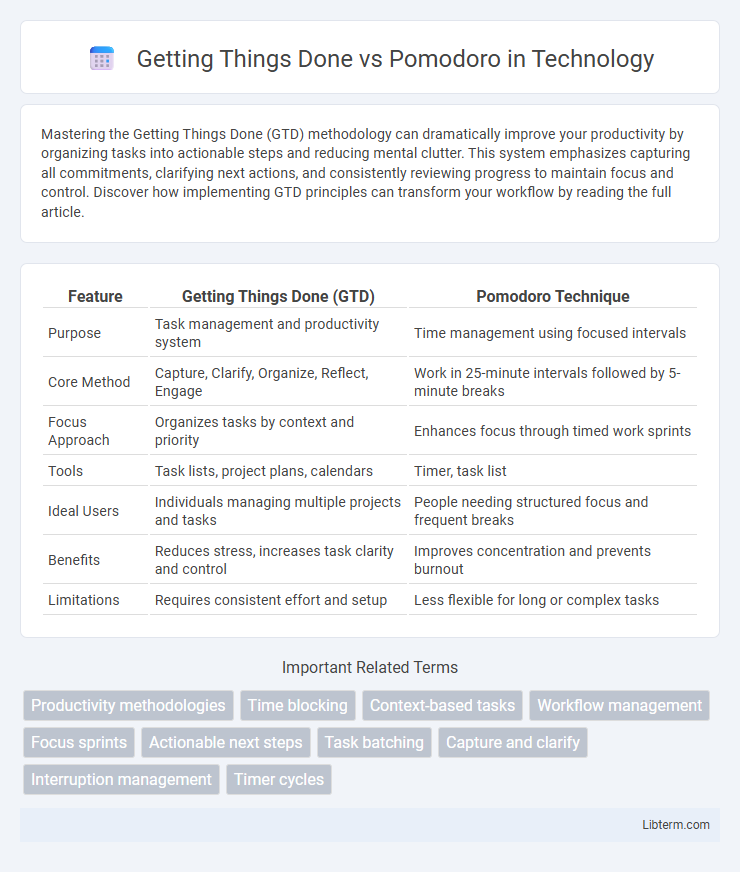Mastering the Getting Things Done (GTD) methodology can dramatically improve your productivity by organizing tasks into actionable steps and reducing mental clutter. This system emphasizes capturing all commitments, clarifying next actions, and consistently reviewing progress to maintain focus and control. Discover how implementing GTD principles can transform your workflow by reading the full article.
Table of Comparison
| Feature | Getting Things Done (GTD) | Pomodoro Technique |
|---|---|---|
| Purpose | Task management and productivity system | Time management using focused intervals |
| Core Method | Capture, Clarify, Organize, Reflect, Engage | Work in 25-minute intervals followed by 5-minute breaks |
| Focus Approach | Organizes tasks by context and priority | Enhances focus through timed work sprints |
| Tools | Task lists, project plans, calendars | Timer, task list |
| Ideal Users | Individuals managing multiple projects and tasks | People needing structured focus and frequent breaks |
| Benefits | Reduces stress, increases task clarity and control | Improves concentration and prevents burnout |
| Limitations | Requires consistent effort and setup | Less flexible for long or complex tasks |
Introduction to Productivity Methods
Getting Things Done (GTD) emphasizes task organization and prioritization through capturing, clarifying, and reviewing commitments to enhance long-term productivity. The Pomodoro Technique structures work into focused intervals, typically 25 minutes, separated by short breaks to maintain high concentration and prevent burnout. Both methods target productivity improvement but differ in approach; GTD offers a comprehensive workflow for managing tasks, while Pomodoro centers on time management and sustained focus.
Overview of Getting Things Done (GTD)
Getting Things Done (GTD) is a productivity methodology developed by David Allen that emphasizes capturing all tasks and ideas into a trusted system to clear mental clutter. This system consists of five key stages: capturing, clarifying, organizing, reflecting, and engaging, which helps individuals manage commitments effectively. GTD aims to improve focus and reduce stress by ensuring that all tasks are prioritized and actionable within a structured workflow.
Overview of the Pomodoro Technique
The Pomodoro Technique is a time management method that breaks work into focused intervals, typically 25 minutes, called "pomodoros," separated by short breaks. This approach enhances concentration and reduces mental fatigue by encouraging sustained productivity and regular rest. It contrasts with Getting Things Done, which emphasizes task organization and workflow management rather than fixed work intervals.
Core Principles: GTD vs Pomodoro
Getting Things Done (GTD) centers on capturing, clarifying, organizing, reflecting, and engaging with tasks to create a comprehensive workflow that reduces mental clutter and enhances productivity. The Pomodoro Technique emphasizes working in focused intervals, typically 25 minutes, followed by short breaks to maintain high levels of concentration and prevent burnout. While GTD provides a broad framework for managing all tasks and commitments, Pomodoro hones in on time management by breaking work into manageable, timed segments.
Time Management Approaches Compared
Getting Things Done (GTD) emphasizes comprehensive task organization and prioritization to improve long-term productivity by breaking projects into actionable steps and maintaining a trusted system for task capture. The Pomodoro Technique centers on short, focused work intervals of 25 minutes followed by 5-minute breaks to boost concentration and reduce mental fatigue during task execution. Comparing these time management approaches reveals GTD as a strategic framework for managing complex workloads, while Pomodoro offers a tactical method to enhance focus and time awareness during individual work sessions.
Task Organization and Prioritization
Getting Things Done (GTD) emphasizes comprehensive task organization through detailed project lists and context-based categorization, enabling effective prioritization by clarifying actionable next steps. In contrast, Pomodoro focuses on time management by dividing work into discrete intervals, promoting prioritization through timed task execution and frequent breaks to maintain focus. Both methods enhance productivity but differ as GTD offers a robust framework for organizing and prioritizing tasks, while Pomodoro optimizes task completion through focused time segmentation.
Flexibility and Adaptability
Getting Things Done (GTD) offers greater flexibility by allowing users to capture and organize tasks freely without rigid time constraints, enabling prioritization based on context and available resources. The Pomodoro Technique emphasizes adaptability through fixed work intervals and breaks, promoting sustained focus but requiring adherence to a structured time-block system. GTD's open framework accommodates varying workflows and sudden task changes, while Pomodoro's timeboxing optimizes productivity cycles for those who thrive under consistent scheduling.
Pros and Cons of Each Method
Getting Things Done (GTD) excels in managing complex tasks and prioritizing multiple projects by breaking work into actionable steps, enhancing overall productivity and reducing mental clutter. However, GTD can be overwhelming to implement initially due to its detailed workflows and frequent reviews. The Pomodoro Technique optimizes focus and combats procrastination through timed work intervals and breaks, making it ideal for maintaining sustained attention, but it may disrupt flow during deep, creative tasks and is less suited for managing long-term projects.
Choosing the Right Method for You
Choosing between Getting Things Done (GTD) and Pomodoro depends on your work style and task complexity. GTD excels at managing multiple projects with detailed lists and prioritization, ideal for those who thrive on structure and long-term planning. Pomodoro suits individuals seeking focused bursts of productivity with regular breaks, enhancing concentration on single tasks and reducing burnout.
Final Thoughts and Recommendations
Getting Things Done (GTD) excels in managing complex projects with its detailed task organization and prioritization framework, while the Pomodoro Technique enhances focus through timed work intervals and frequent breaks. For those juggling multiple long-term goals, GTD provides comprehensive productivity management, whereas Pomodoro benefits individuals seeking to combat procrastination and maintain concentration during shorter tasks. Combining GTD's structured approach with Pomodoro's time-blocking can maximize efficiency and reduce mental fatigue.
Getting Things Done Infographic

 libterm.com
libterm.com